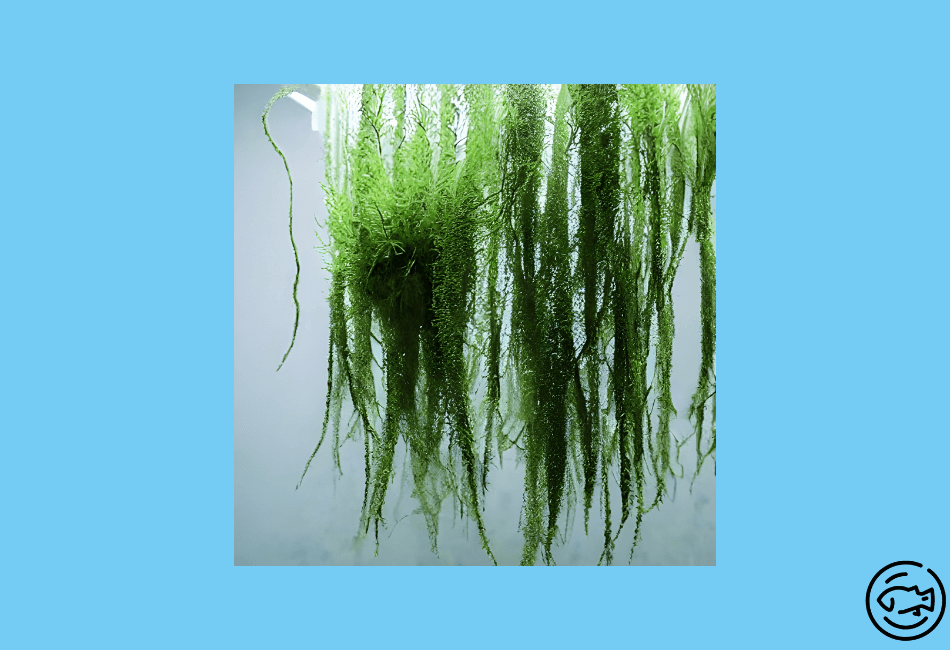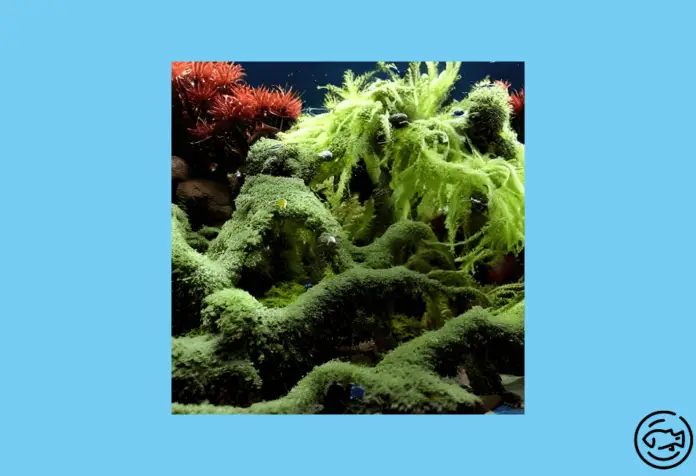Weeping Moss also recognized as Vesicularia Ferriei, is a popular aquatic plant that adds variety to an aquarium’s appearance.
This moss type, when thriving, grows expansively both submerged or emersed. Nevertheless, it can only survive outside water in a highly humid environment.
Continue reading to master the art of nurturing and propagating Weeping Moss.
| Attribute | Information |
|---|---|
| Usual Name | Weeping Moss |
| Scientific Name | Vesicularia Ferriei |
| Source | Indigenous to China, present across Asia and Europe |
| Growth & Dimension | Maximum 1 inch |
| Temperature Range | 60 to 85°F |
| pH Scale | 5.1 – 6.0 |
What Is Weeping Moss?

Weeping Moss (Vesicularia Ferriei) is a distinct aquatic moss known for its cascading growth pattern, and this unique characteristic has led to its use in numerous renowned aquascapes.
Its vibrant green hue and delicate texture further enhance the plant’s appeal, and it typically grows up to an inch tall.
The plant doesn’t root in the substrate, so it must be affixed to an object like driftwood or rock. Although lacking roots, Weeping Moss possesses rhizoids, enabling it to secure itself to surfaces naturally.
However, these rhizoids do not absorb nutrients, making the plant a water column feeder. In the wild, the Moss thrives on moist rocks, riverbanks, and damp soil near watercourses.
Originally from China, Weeping Moss has gained global availability due to its widespread popularity among aquarium enthusiasts. Numerous online vendors also supply the plant.
Nonetheless, it is crucial to be aware that the Moss is often misidentified with other aquarium moss varieties. Thus, it is essential to source the plant from a reliable vendor.
Weeping Moss Care
It is a resilient and versatile plant, making it simple to cultivate. These freshwater mosses can flourish in diverse conditions and water parameters, making them suitable for novice and experienced aquarists.
In terms of water parameters, the plant thrives in temperatures between 60 and 85°F and a pH range of 5.1 to 6.0.
As for lighting requirements, the Moss is quite adaptable and doesn’t necessitate specialized aquarium lighting, and the plant will grow more quickly under moderate light but can survive in low-light conditions.
Occasional trimming may be required to maintain the plant’s desired size.
Healthy Moss will exhibit a cascading growth pattern, and insufficient growth might indicate a lack of nutrients in the water.
While supplemental fertilizers can be added, they may also promote algae growth, so regular aquarium monitoring is essential.
Remember that a newly added plant may grow slowly as it adjusts to its new surroundings. Once established, it will expand outward.
Pruning the shoot tips will stimulate new growth.
Propagation and cultivation of the plant can be easily achieved through trimming and division.
Weeping Moss Facts
It is an exceptionally resilient plant that thrives in a range of water parameters and illumination settings.
As Weeping Moss lacks roots to fasten itself to the substrate, it necessitates attachment to an object using strings or adhesive.
Introduced to the aquarium hobby in 2004, Weeping Moss is frequently mislabeled even today, making it crucial to verify the correct identification of the plants.
How To Attach Weeping Moss To Driftwood
Weeping Moss lacks roots, meaning it can’t be anchored in the substrate. However, there are several straightforward methods for planting it in your aquarium.
One way to attach Weeping Moss to driftwood or rock is by using string to tie the Moss to the desired object.
There’s no need for multiple strings or knots; a single loop around the Moss and the object should suffice. Be careful not to tie the knot too tightly, and ensure it sits snugly against the object for proper attachment.
Another option for securing the Moss is using super glue.
The drawback is that you must remove and dab dry your driftwood or stone for proper adhesion. The wood can be slightly damp but not soaked. The super glue may discolor the driftwood where applied, but the Moss will soon grow to conceal the area.
You can weigh it with rocks if you prefer not to tie or glue the Moss.
Position the Weeping Moss where desired and place a few small stones on top to hold it in place. Fish or snails in your tank may dislodge the rocks, so check on the Moss regularly and reposition the rocks as needed.
You can also embed it into your driftwood by breaking up the moss cluster and placing it in the holes and crevices of the wood. While the Moss will eventually attach and grow this way, fish or other aquatic creatures may dislodge it, requiring you to reposition the Moss.
Also read: Dwarf Hairgrass – Care, Requirements, Carpet & More!
Do Weeping Moss Need CO2?
Lacking roots, Weeping Moss relies on light and water conditions for growth as it can flourish across a broad spectrum of water parameters.
While the Moss doesn’t require CO2 for effective growth within an aquarium, the presence of CO2 can accelerate its growth rate and enhance the downward curvature of its offshoots.
Should your Moss fail to meet your growth expectations, you can provide additional support by supplementing it with fertilizers.
Weeping Moss Propagation
The Weeping Moss is a pleurocarpous plant, meaning that it develops tiny stems featuring tips containing spores during propagation.
These spores are released, giving rise to new Weeping Moss clusters.
To ensure optimal growth, make sure to maintain a suitable environment by fine-tuning the water parameters to meet the plant’s needs.
Weeping Moss Turning Brown?
Weeping Moss is a resilient plant, but if water parameters are unsuitable or conditions become too harsh, the plant may begin to turn brown. Browning typically starts at the tips and progresses downward.
Fortunately, if detected early, the Moss can be rejuvenated.
If you observe browning, check the water parameters, clean the moss tank, trim away the dead parts of the plant, and continue monitoring its progress.
One issue Weeping Moss may encounter is algae growth on the plant itself.
Excessive light and improper tank cleaning can lead to algae buildup on the Moss, blocking essential light and nutrients.
This can harm the plant and cause it to turn brown.
Weeping Moss Vs Java Moss
Weeping Moss and Java Moss are low-maintenance aquatic moss plants, as they readily adapt to various water parameters.
Java Moss, like Weeping Moss, proliferates and adheres to objects in the aquarium that it is anchored to. Both mosses display vibrant shades of green, with Java Moss having a lighter hue, while Weeping Moss is significantly darker.
Like the Moss, Java Moss uses rhizoids to anchor itself and requires trimming to maintain its preferred shape and size.
Both plants are excellent choices for breeding tanks, providing safe spaces for egg-scattering fish, hiding spots, and an aesthetically pleasing appearance.
Weeping Moss grows its offshoots downward, resembling the branches of a Weeping Willow Tree.
In contrast, Java Moss has upward-growing, long, thin shoots and grows somewhat faster.
Java Moss is commonly available at most aquarium stores, but Weeping Moss may need to be purchased through an online distributor.
Conclusion
By now, it’s clear why Weeping Moss plants have become increasingly popular over the years. A small cluster of Moss can quickly spread under ideal conditions. Here are some key reasons to consider planting Weeping Moss in your aquarium:
- It grows like lush miniature trees.
- They are uncommon and provide an intriguing visual element in a well-lit vivarium.
- The Moss serves a functional purpose, as fish use them as egg-laying sites.
- It doesn’t require specialized UV lights and is beginner-friendly.
So, we recommend that you try these pleurocarpous plants and reap their numerous benefits, and share your experience with us in the comments section below.


